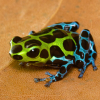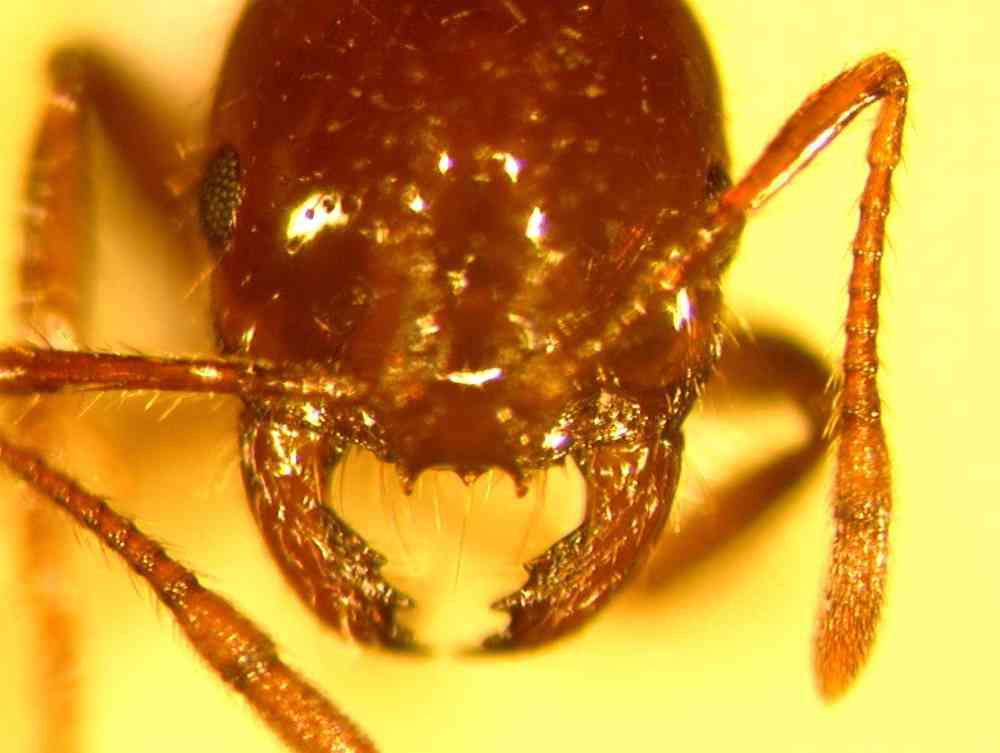I always have such a hard time telling these two apart
- Formiculture.com
- Forums
- Gallery
- Members
- Member Map
- Chat

I always have such a hard time telling these two apart
The easiest way is to look at the clypeus.
Solenopsis invicta has a median clypeal tooth, the spike in the middle:

Whereas Solenopsis xyloni (and Solenopsis geminata) lack the middle tooth:
Edited by Batspiderfish, October 28 2017 - 4:19 PM.
If you've enjoyed using my expertise and identifications, please do not create undue ecological risk by releasing your ants. The environment which we keep our pet insects is alien and oftentimes unsanitary, so ensure that wild populations stay safe by giving your ants the best care you can manage for the rest of their lives, as we must do with any other pet.
Exotic ants are for those who think that vibrant diversity is something you need to pay money to see. It is illegal to transport live ants across state lines.
----
Black lives still matter.
Thanks.. looks really hard to see though
Is the spike on the queens too?
Edited by soulsynapse, October 28 2017 - 4:47 PM.
It's not quite as clear with the queens, but the clypeal teeth on Solenopsis invicta queens are smoothly defined and needle-like, while S. xyloni's are more broad and angular. It is much easier to look at the workers.
Identification requires attention to fine details.
Edited by Batspiderfish, October 28 2017 - 5:16 PM.
If you've enjoyed using my expertise and identifications, please do not create undue ecological risk by releasing your ants. The environment which we keep our pet insects is alien and oftentimes unsanitary, so ensure that wild populations stay safe by giving your ants the best care you can manage for the rest of their lives, as we must do with any other pet.
Exotic ants are for those who think that vibrant diversity is something you need to pay money to see. It is illegal to transport live ants across state lines.
----
Black lives still matter.
Thanks.. looks really hard to see though
Is the spike on the queens too?
Yes, though unless you're looking at a dead queen it's pretty difficult to side one way or the other as you need a very specific angle to view it. S. invicta S. xyloni. The middle spike is also somewhat under the head making it easy to mistake which (unless this is a mistake?).
S. invicta is a species of disturbance that has high moisture requirements. This makes them very common in suburban and agricultural areas where people are maintaining lawns and regularly watering crops. During the dryer parts of the year though they retreat deeper in the soil. Often when you find one queen there are at least twenty more wondering about nearby, and sometimes whole parking lots and swimming pools are absolutely covered in them! Again though they require a certain level of moisture for their colonies to be successful.
S. xyloni is a species usually found in deserts or adjacent habitats, such as slightly up in the mountains. They're nowhere near as invasive as S. invicta, though they can be just as industrious. When you find a colony of these it may well be the only colony of that species for quite a distance (an acre?).
Edited by MrILoveTheAnts, October 28 2017 - 5:15 PM.
North America: Ant Genera, Species List, "Native Plants for Honeybees" | My YouTube Channel
Yeah, differentiating these two can be tricky, but not hard. Finding S. invicta in Socal is rare.
At the beginning of this year, we had an incident where a newby GAN farmer posted a supposed S. invicta for sale ($20 haha). All the CA GAN farmers had an internal email pointing this out to Mikey, and it was removed without fuss (not a big deal, no drama, happened once).
But knowing how rare S. invicta are here in the dry Southern CA desert, I was pretty sure it was misidentified as S. xyloni or even possibly a species of Pogonomyrmex.
I've sold S. xyloni to kids before, and almost always their response is "omg it's so small!" (twss ![]() )
)
I ask why, and they send images of P. californicus from their backyard, assuming those were Solenopsis.
Instagram:
nurbsants
YouTube
California Ants for Sale
Unidentified Myrmecocystus
https://www.formicul...ls-near-desert/
Undescribed "Modoc"
https://www.formicul...mp-ca-5-4-2017/
Camponotus or Colobopsis yogi:
https://www.formicul...a-ca-1-28-2018/
Camponotus us-ca02
https://www.formicul...onotus-us-ca02/
Unidentified Formica
https://www.formicul...l-ca-6-27-2020/
Pencil Case and Test Tube Formicariums
https://www.formicul...m-and-outworld/
Bloodworm Soup
https://www.formicul...bloodworm-soup/
In a chat with James Trager he tells me, "dark stripes on mesothorax and mid-frons are diagnostic for invicta." This seems to ring true though I see there is a bit of a range here.
S. xyloni
Solid color, Somewhat darker, Starting to show, Somewhat dark patches. Though even at their darkest they seem to be a dark brown/red.
S. invicta
Dark brown, Clearly black, Fairly typical (but only with two spikes?), Getting Darker, Burnt, Overcooked, Black almost.
North America: Ant Genera, Species List, "Native Plants for Honeybees" | My YouTube Channel
Is "overcooked" a scientific term?
Instagram:
nurbsants
YouTube
California Ants for Sale
Unidentified Myrmecocystus
https://www.formicul...ls-near-desert/
Undescribed "Modoc"
https://www.formicul...mp-ca-5-4-2017/
Camponotus or Colobopsis yogi:
https://www.formicul...a-ca-1-28-2018/
Camponotus us-ca02
https://www.formicul...onotus-us-ca02/
Unidentified Formica
https://www.formicul...l-ca-6-27-2020/
Pencil Case and Test Tube Formicariums
https://www.formicul...m-and-outworld/
Bloodworm Soup
https://www.formicul...bloodworm-soup/
Is "overcooked" a scientific term?
I hope not, but Milta may be speaking from experience...
Is "overcooked" a scientific term?
No, just what I decided to title the link. Compared to the others in the line up she certainly looks that way... also I'm currently baking cookies so there maybe a subliminal message on my part.
See it's not so much one trait identifying one species from the other, but these things should be suggestive. (Apparently S. xyloni hybridizes with a few other of the native ones too along with natural diversity within the species.)
North America: Ant Genera, Species List, "Native Plants for Honeybees" | My YouTube Channel
0 members, 1 guests, 0 anonymous users